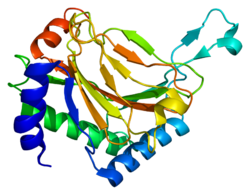
EGLN1

2G19, 2G1M, 2HBT, 2HBU, 2Y33, 2Y34, 3HQR, 3HQU, 3OUH, 3OUI, 3OUJ, 4BQW, 4BQX, 4BQY, 4JZR, 4KBZ, 4UWD, 5A3U54583112405ENSG00000135766ENSMUSG00000031987Q9GZT9Q91YE3NM_022051NM_053207NM_001363475NP_071334NP_444437NP_001350404Hypoxia-inducible factor prolyl hydroxylase 2 (HIF-PH2), or prolyl hydroxylase domain-containing protein 2 (PHD2), is an enzyme encoded by the EGLN1 gene. It is also known as Egl nine homolog 1. PHD2 is a α-ketoglutarate/2-oxoglutarate-dependent hydroxylase, a superfamily non-haem iron-containing proteins. In humans, PHD2 is one of the three isoforms of hypoxia-inducible factor-proline dioxygenase, which is also known as HIF prolyl-hydroxylase.2g19: Cellular Oxygen Sensing: Crystal Structure of Hypoxia-Inducible Factor Prolyl Hydroxylase (PHD2)2g1m: Cellular Oxygen Sensing: Crystal Structure of Hypoxia-Inducible Factor Prolyl Hydroxylase (PHD2)2hbt: Crystal structure of HIF prolyl hydroxylase EGLN-1 in complex with a biologically active inhibitor2hbu: Crystal structure of HIF prolyl hydroxylase EGLN-1 in complex with a biologically active inhibitor Hypoxia-inducible factor prolyl hydroxylase 2 (HIF-PH2), or prolyl hydroxylase domain-containing protein 2 (PHD2), is an enzyme encoded by the EGLN1 gene. It is also known as Egl nine homolog 1. PHD2 is a α-ketoglutarate/2-oxoglutarate-dependent hydroxylase, a superfamily non-haem iron-containing proteins. In humans, PHD2 is one of the three isoforms of hypoxia-inducible factor-proline dioxygenase, which is also known as HIF prolyl-hydroxylase. HIF-1α is a ubiquitous, constitutively synthesized transcription factor responsible for upregulating the expression of genes involved in the cellular response to hypoxia. These gene products may include proteins such as glycolytic enzymes and angiogenic growth factors. In normoxia, HIF alpha subunits are marked for the ubiquitin-proteasome degradation pathway through hydroxylation of proline-564 and proline-402 by PHD2. Prolyl hydroxylation is critical for promoting pVHL binding to HIF, which targets HIF for polyubiquitylation. PHD2 is a 46-kDa enzyme that consists of an N-terminal domain homologous to MYND zinc finger domains, and a C-terminal domain homologous to the 2-oxoglutarate dioxygenases. The catalytic domain consists of a double-stranded β-helix core that is stabilized by three α-helices packed along the major β-sheet. The active site, which is contained in the pocket between the β-sheets, chelates iron(II) through histidine and aspartate coordination. 2-oxoglutarate displaces a water molecule to bind iron as well. The active site is lined by hydrophobic residues, possibly because such residues are less susceptible to potential oxidative damage by reactive species leaking from the iron center. PHD2 catalyses the hydroxylation of two sites on HIF-α, which are termed termed the N-terminal oxygen dependent degradation domain (residues 395-413, NODD) and the C-terminal oxygen dependent degradation domain (residues 556-574, CODD). These two HIF substrates are usually represented by 19 amino acid long peptides in in vitro experiments. X-ray crystallography and NMR spectroscopy showed that both peptides bind to the same binding site on PHD2, in a cleft on the PHD2 surface. An induced fit mechanism was indicated from the structure, in which residues 237-254 adopt a closed loop conformation, whilst in the structure without CODD or NODD, the same residues adopted an open finger-like conformation. Such conformational change was confirmed by NMR spectroscopy, X-ray crystallography and molecular dynamics calculations. A recent study found a second peptide binding site on PHD2 although peptide binding to this alternative site did not seem to affect the catalytic activity of the enzyme. Further studies are required to fully understand the biological significance of this second peptide binding site. The enzyme has a high affinity for iron(II) and 2-oxoglutarate (also known as α-ketoglutarate), and forms a long-lived complex with these factors. It has been proposed that cosubstrate and iron concentrations poise the HIF hydroxylases to respond to an appropriate 'hypoxic window' for a particular cell type or tissue. Studies have revealed that PHD2 has a KM for dioxygen slightly above its atmospheric concentration, and PHD2 is thought to be the most important sensor of the cell's oxygen status. The enzyme incorporates one oxygen atom from dioxygen into the hydroxylated product, and one oxygen atom into the succinate coproduct. Its interactions with HIF-1α rely on a mobile loop region that helps to enclose the hydroxylation site and helps to stabilize binding of both iron and 2-oxyglutarate. A feedback regulation mechanism that involves the displacement of HIF-1α by hydroxylated HIF-1α when 2-oxoglutarate is limiting was also proposed. PHD2 is the primary regulator of HIF-1α steady state levels in the cell. A PHD2 knockdown showed increased levels of HIF-1α under normoxia, and an increase in HIF-1α nuclear accumulation and HIF-dependent transcription. HIF-1α steady state accumulation was dependent on the amount of PHD silencing effected by siRNA in HeLa cells and a variety of other human cell lines. However, although it would seem that PHD2 downregulates HIF-1α and thus also tumorigenesis, there have been suggestions of paradoxical roles of PHD2 in tumor proliferation. For example, one animal study showed tumor reduction in PHD2-deficient mice through activation of antiproliferative TGF-β signaling. Other in vivo models showed tumor-suppressing activity for PHD2 in pancreatic cancer as well as liver cancer. A study of 121 human patients revealed PHD2 as a strong prognostic marker in gastric cancer, with PHD2-negative patients having shortened survival compared to PHD2-positive patients. Recent genome-wide association studies have suggested that EGLN1 may be involved in the low hematocrit phenotype exhibited by the Tibetan population and hence that EGLN1 may play a role in the heritable adaptation of this population to live at high altitude.
